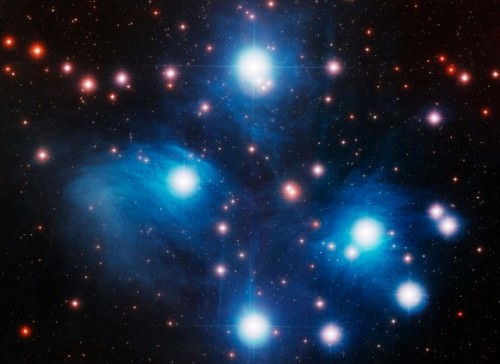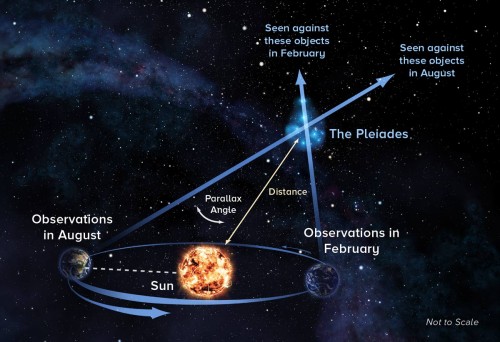A new measurement claims that the distance to the Pleiades star cluster measured by the European Space Agency's Hipparchus satellite is incorrect and that previous measurements from ground-based telescopes were right all along

Autumn is approaching and with it the cluster of the Pleiades (Kima stars in the Hebrew sources) that will shine early in the night sky. The cluster is named after the seven sisters, daughters of the Titan Atlas and the nymph Pleiades and companions of Artemis. In Hebrew it is called Kima and is mentioned in the Bible in the book of Job (Lach, XNUMX) and in the book of Amos (XNUMX, XNUMX). In the Babylonian Talmud (Blessings Tractate, Noah page, end of the seer chapter), where it is claimed that there are a hundred stars in the cluster. (Source: Wikipedia) In Japanese, the cluster's name is Subaru and the seven-star model appears on the logo of the car company bearing this name.
Indeed, while the group has been known since ancient times, in the last decade a dispute has troubled astronomers as to the distance to it.
Now, a new measurement claims that the distance to the Pleiades star cluster measured by the European Space Agency's Hipparchus satellite is incorrect and that previous measurements from ground-based telescopes were right all along.
The Pleiades star cluster is a perfect laboratory for studying stellar evolution. All the stars - the seven visible to the eye and hundreds more that can only be seen in telescopes, were born from the same cloud of gas, they are of the same age and have the same chemical composition. However, they differ from each other in their mass. Accurate models, however, are highly dependent on distance. Therefore it is critical that astronomers know the exact distance to the star cluster.
The distance measurement has an implication not only for measuring the distance of this particular cluster but it is also used as a gauge to calibrate the distances to the other objects in the universe. In other words, knowing the exact distance to a cluster will help measure accurate distances to the most distant galaxies.

But accurate measurement of the vast distances in space is complicated. Trigonometric parallax - the tiny visible change in the position of the object against background stars as a result of the displacement of the observation point is the most accurate method in astronomy.
The consensus was that the Pleiades lie 435 light years from Earth. However, the European Space Agency's Hipparchus satellite, launched in 1989, accurately studied the position and distances of thousands of stars using parallax, and calculated that the cluster was only 392 light years from Earth with an error of less than 1%.
"It may not seem like a huge difference, but in order to match the physical properties of the Pleiades stars, it challenged our general understanding of how stars form and evolve," said Carl Melis, of the University of California, San Diego, the lead researcher. "To accommodate Hipparchus' distance measurement, some astronomers have even suggested the existence of some kind of new and unknown physics in such young stars."
If the cluster is really 10% closer than we all thought, the stars should be much fainter than the stellar evolution models suggest, so the debate revolves around the question of who was wrong, the spacecraft or the model?
To resolve the discrepancy, Melis and his colleagues used a new technique known as very long-baseline radio interferometry. By linking distant telescopes together, the astronomers created a virtual telescope, with a data collection surface the size of the distance between the telescopes.
The network included the baseline of the Very Long Array (a system of 10 radio telescopes ranging from Hawaii to the Virgin Islands), the Green Bank Telescope in West Virginia, the Gordon Telescope at the Arecibo Observatory in Puerto Rico, and the Apelsberg Radio Telescope in Germany.
"Using these telescopes together gave us the equivalent of an Earth-sized telescope," said Amy Miodzewski, of the National Radio Astronomy Observatory (NRAO). "This gave us the ability to make extremely accurate position measurements, equivalent to measuring the thickness of a coin in Los Angeles as seen from New York."
After a year and a half of observations, the team determined that the distance to the Pleiades is 444.0 light-years within an error range of 1% - that is, closer to the previous ground-based results and not to those of Hipparchus.
"The question now is what happened to Hiparchus?" said Melis.
The spacecraft measured the position of about 120,000 nearby stars and, in principle, could measure the distances more precisely than with ground-based telescopes. If this result holds, astronomers will have to deal with why Hipparchus' observations estimated the distance so inaccurately.
The European Space Agency's observatory - the Gaia spacecraft, which was launched in December 2013 - will use similar technology to measure the distances of about a billion stars. Although it is now ready to begin its science mission, the mission team will need to perform special treatment, utilizing the work of ground-based radio telescopes to ensure accurate measurements.
The findings were published in the August 29 issue of the journal Science and available online.

8 תגובות
The distance to Kima is 420 light-years....according to the connection with the Pleiades
Go to the link at the end of the article.
In the new measurement the distances are:
The measured distances and ±1 SD errors for the four systems
are 134.8±0.5 pc (HII 174), 138.4±1.1 pc (HII 625), 135.5±0.6 pc (HII 1136), and 136.6±0.6 pc
(HII 2147 system). Of note is the <1% accuracy for the individual object VLBI distance
measurements.
The distance to the cluster is some kind of average over these numbers.
In contrast, the distance measured by Hipparchus - 120.2±1.5 pc - does not refer to individual objects but to the entire cluster:
For a single object near the distance of the Pleiades, Hipparcos was not capable of
producing a distance measurement with accuracy better than 10%. However, by taking the
aggregate of many cluster members, Hipparcos was able to achieve a Pleiades parallax with
roughly 1% precision (6,7).
distance from what? From the center of mass of the cluster? From the nearest star? The brightest? The dimensions of the cluster itself are of the order of tens of light years.
Eyal
This is a very prominent group that is also seen in the city. You mentioned that the group is mentioned in the Torah - I wonder how you know the connection between the name mentioned in the Torah and the group of stars. By the way, another group, the hunter (Orion) is also mentioned in the same place (Book of Job).
Maybe God was acting in his mind then?
Got it thanks, I just thought this group was indistinguishable without a telescope, but it turns out I was wrong. It can be clearly seen, especially on a dark night outside an urban area (which was abundant during the Torah period...)
The answer - they didn't treat it as a cluster, for them it was the same whether these seven stars were close to each other or millions of light years away from each other, for them the sky was flat. They simply treated this cluster as a special group, but also treated the zodiac signs that way even though there is no connection other than the line of sight between the stars that make them up.
Tam asked, how is it possible that this star cluster is mentioned in the Torah? After all, they didn't have telescopes at that time, how could they know that a small point of light in the sky is a cluster of stars and not one single star?
(For example, when I look at the night sky, I can't find a cluster of stars again... not even with binoculars)
The debate was not resolved, but intensified, and a confrontation between Europe and America was created. The European scientists who built the Hipparchus satellite still do not receive the new measurements described in the article. The Americans claim that Gaia will also get erroneous results, because it uses methods similar to Hiparchus. As the Chinese say - there will be some interesting years.